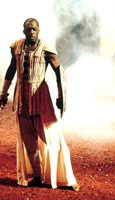Rob Howell

Rob Howell is currently riding high in the world of theatre design, with a hit show (the stage adaptation of The Graduate) in London’s West End and an Olivier award for Best Designer 2000 on his mantelpiece.
But it is a measure of the insecurity of this most enviable of jobs that Howell is anything but complacent. ‘I still feel a bit numb about the Olivier award. So far it hasn’t made a significant difference to my workload. I like to think designers get work because a theatre or a director seeks you out, rather than a group of randomly selected strangers deciding you’re the best,’ he says.
The award was made on the basis of three shows he did as part of Trevor Nunn’s repertory at the National Theatre. They were Shakespeare’s Troilus and Cressida, a little-known Victorian play called Money, and a new play, Battle Royal.
‘Having a chance to work with Trevor Nunn on that scale was unmissable. When I was at art college I’d written essays about Nunn and the designer John Napier, and all of a sudden, there I was sitting in meetings with these two giants of modern theatre,’ he says.
Though he credits Napier – the designer of Starlight Express and Cats – with having ‘reinvented what people expect from theatre design,’ it is clear that Howell himself prefers the more minimalist approach.
‘I want to ask audiences to use their imagination. My aim is to try to distil the world we’re putting in front of people down to the most potent objects, shapes and colours,’ he says.
In The Graduate, for example, he uses acres of louvred doors to suggest the feel and culture of upper middle class America during the 1960s.
‘The work I did on that wasn’t at all bound up with the movie. Obviously, I knew how striking the film was, but I’m too young to appreciate how culturally important it was at the time. I just knew I wanted it to be light and seductive, not heavy, so it was important to have a lot of clear space on stage to enable the actors to express themselves physically,’ says Howell.
Like most top theatre designers, Howell divides his time between shows destined for the West End – the big subsidised companies (which pay the best) – and the more prestigious fringe companies, like London’s Almeida and the Donmar Warehouse, which can only afford to pay designers £2000 per job.
‘This is why theatre designers never take any time off and always take on more work than they should. In an ideal world, we shouldn’t have to do more than four or five shows a year, but if you only worked for the smaller companies, you’d earn about £10 000 a year,’ he says.
Howell is happy to describe himself as a ‘gun for hire’ and spurns Bob Crowley’s practice of working with a tight band of trusted directors.
‘I look at designers who have a special working relationship with a particular director and think “that must be great”, but my worry is that the shorthand you’d evolve might mean that you wouldn’t explore as much as you should.
‘I do believe in the cross-fertilisation of ideas that you get from working with lots of different people. I’m sure throwing yourself in the deep end every now and then can actually lead to a richer experience.’
-
Post a comment




